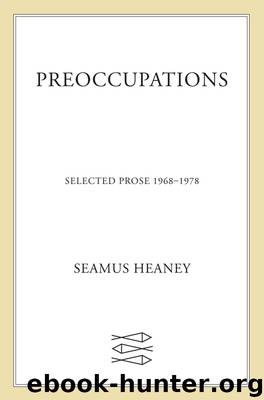Preoccupations by Seamus Heaney

Author:Seamus Heaney
Language: eng
Format: epub
Publisher: Farrar, Straus and Giroux
The Sense of Place
I think there are two ways in which place is known and cherished, two ways which may be complementary but which are just as likely to be antipathetic. One is lived, illiterate and unconscious, the other learned, literate and conscious. In the literary sensibility, both are likely to co-exist in a conscious and unconscious tension: this tension and the poetry it produces are what I want to discuss. I want to consider how the different senses of Ireland, of Northern Ireland, and of specific places on our island, have affected poets over these last hundred years.
I might have begun the exploration much further back, of course, because in Irish poetry there is a whole genre of writing called dinnseanchas, poems and tales which relate the original meanings of place names and constitute a form of mythological etymology. An early epic like the Tain bo Cuailgne is full of incidental dinnseanchas, insofar as it connects various incidents on the journey of the Connacht armies from Cruachan to Carlingford with the names of places as we now know them, or at least as they were known in the Gaelic past. Ardee, for example, the town in Co. Louth. In Irish, Ardee means Ferdia’s Ford, and it was at this point (at a ford on the River Fane) that Cuchullain and Ferdia, brothers in arms in their youth, fought their great single combat by day and tended each other’s wounds by night until Cuchullain slew Ferdia with his magical weapon, the gae bolga. It is a story that would have been current in everybody’s mind when Irish was the lingua franca and it is still one of the best known and best loved legends in the Ulster cycle. So the place name, Ardee, succinctly marries the legendary and the local.
It now requires some small degree of learning to know this about Ardee. We have to retrieve the underlay of Gaelic legend in order to read the full meaning of the name and to flesh out the topographical record with its human accretions. The whole of the Irish landscape, in John Montague’s words, is a manuscript which we have lost the skill to read. When we go as tourists to Donegal or Connemara or Kerry we go with at best an aesthetic eye, comforting ourselves with the picturesqueness of it all or rejoicing in the fact that it is unspoiled. We will have little felt knowledge of the place, little enough of a sense of wonder or a sense of tradition. Tory Island, Knocknarea, Slieve Patrick, all of them deeply steeped in associations from the older culture, will not stir us beyond a visual pleasure unless that culture means something to us, unless the features of the landscape are a mode of communion with a something other than themselves, a something to which we ourselves still feel we might belong.
On the other hand, as we pass south along the coast from Tory to Knocknarea, we go through the village of Drumcliff and under Ben Bulben, we skirt Lissadell and Innisfree.
Download
This site does not store any files on its server. We only index and link to content provided by other sites. Please contact the content providers to delete copyright contents if any and email us, we'll remove relevant links or contents immediately.
| Diaries & Journals | Essays |
| Letters | Speeches |
The Rules Do Not Apply by Ariel Levy(4859)
Bluets by Maggie Nelson(4472)
Too Much and Not the Mood by Durga Chew-Bose(4271)
Pre-Suasion: A Revolutionary Way to Influence and Persuade by Robert Cialdini(4144)
The Motorcycle Diaries by Ernesto Che Guevara(4009)
Walking by Henry David Thoreau(3892)
Schaum's Quick Guide to Writing Great Short Stories by Margaret Lucke(3318)
What If This Were Enough? by Heather Havrilesky(3270)
The Daily Stoic by Holiday Ryan & Hanselman Stephen(3230)
The Day I Stopped Drinking Milk by Sudha Murty(3159)
The Social Psychology of Inequality by Unknown(2937)
Why I Write by George Orwell(2874)
Letters From a Stoic by Seneca(2736)
A Short History of Nearly Everything by Bryson Bill(2629)
A Burst of Light by Audre Lorde(2546)
Insomniac City by Bill Hayes(2496)
Feel Free by Zadie Smith(2435)
Upstream by Mary Oliver(2341)
Miami by Joan Didion(2322)
